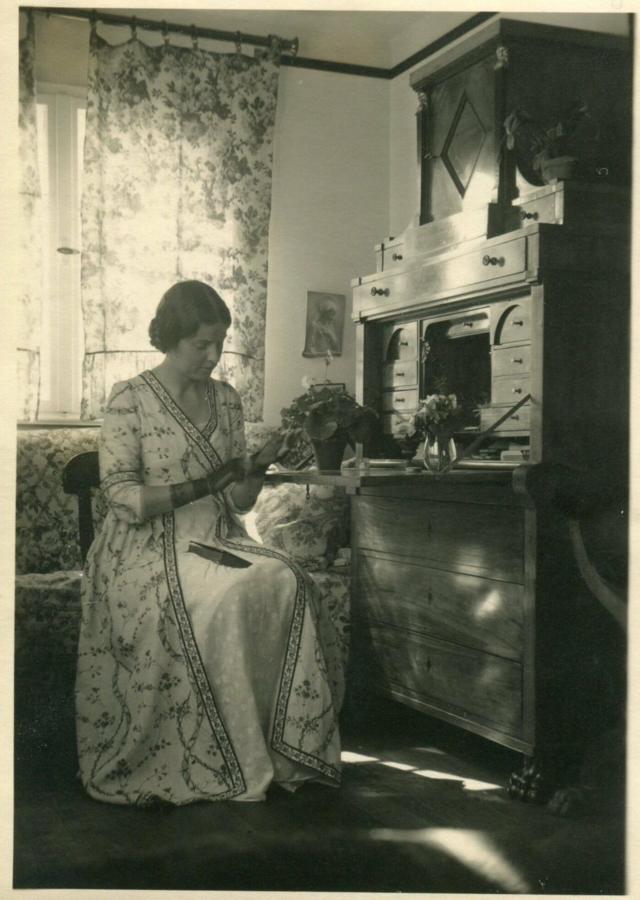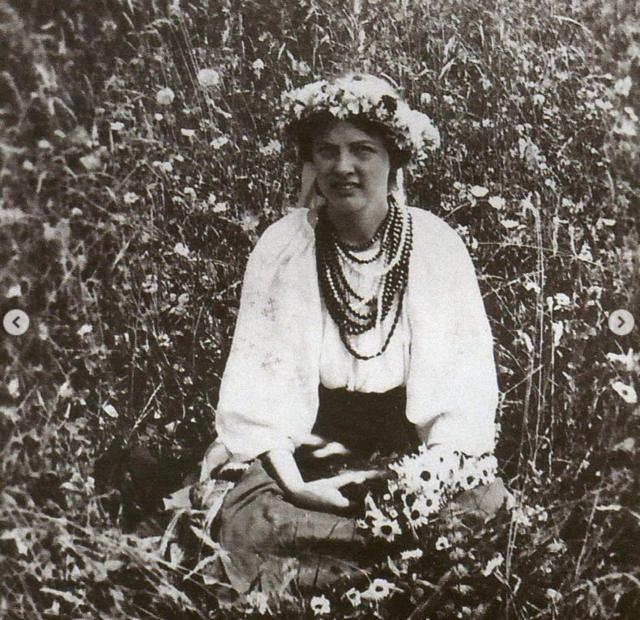Портрет доньки гетьмана Павла Скоропадського століття надихав українську діаспору в Європі. Його передавали у вигляді поштових листівок, а сам оригінал вважали назавжди втраченим у вирі Другої світової війни. Аж раптом Музей гетьманства у Києві отримав несподіваний лист від однієї німецької родини.
Таємнича незнайомка
У мальовничому містечку Оберстдорф, що лежить посеред баварських Альп на півдні Німеччини, родина місцевих фермерів багато років зберігає незвичний портрет.
На ньому – молода і гарна жінка у вінку з квітів, білій вишиванці та зі строкатим намистом. Вона дивиться глибоко в очі кожному, хто погляне на картину. Цей погляд, здається, приховує непросту, але захопливу історію.
Але яку? Хто вона ця таємнича незнайомка, чий портрет 15-річний німецький хлопчик знайшов 40 років тому.
Його донька Катарина Шалль, тепер вже доросла жінка, каже, що, як і її батько, з першого погляду закохалася у картину.
“Кольори, квіти, прикраси та харизма жінки – це якась магія”, – розповіла вона в інтервʼю українському виданню Marie Claire.
Катарина повісила портрет у своїй квартирі. Вона каже, що всі, хто приходив в гості, звертали на нього увагу і запитували, хто ця жінка та яку історію приховує її зображення.
Тоді жінка вирішила провести розслідування й таки дізнатися імʼя незнайомки. На той момент Катарині було відомо лише те, як картина потрапила в її родину.
На початку 1980-их, коли батькові Катарини було 15 років, він побачив у місцевій газеті оголошення про те, що в Оберстдорфі зносять будинок, розповіла жінка журналу Marie Claire.
Хлопчик збирав марки і сподівався знайти у будинку рідкісні екземпляри для своєї колекції. Натомість він побачив картину, яка стояла просто за дверима.
Портрет жінки вразив його, і він спитав у власників, що з ним буде. Але господар відповів, що якщо картину не заберуть, вона опиниться на смітнику. Так батько Катарини Шалль приніс портрет додому й повісив у своїй дитячій кімнаті.
Не сподівалися знайти
Водночас портрет, який прикрашав будинок родини Шалль і про який вони нічого не знали, був дуже відомий серед української діаспори, розповів BBC Україна історик Олександр Алфьоров.
Жінка на портреті – донька останнього гетьмана України Павла Скоропадського, Єлизавета. Вона була відданою помічницею свого батька і активною учасницею Гетьманського руху, очоливши у 1960-70 роках Союз гетьманців-державників.
Портрет гетьманівни, який приблизно у 1920-их роках намалювала художниця Ольга Мордвінова, був добре відомий в еміграції завдяки листівкам, які з нього масово виготовляли. Така листівка є й в колекції самого Алфьорова.
За його словами, портрет Гетьманівни став для української діаспори “уособленням української аристократки, навіть не за походженням, а аристократки духу”.

АВТОР ФОТО,АРХІВ МУЗЕЮ ГЕТЬМАНСТВА Підпис до фото, Фото Єлизавети Скоропадської з архіву Музею гетьманства, де зберігається чимало речей родини
Проте доля самої картини була невідома. Про її існування і про те, що картина зникла, розповідала молодша донька Скоропадського, Олена Павлівна Отт-Скоропадська, коли приїжджала в Україну, каже історик.
Портрета Єлизавети не було в родинній колекції гетьманських портретів, створених подругою Скоропадських – Ольгою Мордвіновою, які пізніше передали до Музею гетьманства.
Дослідники припускали, що портрет загубився під час Другої світової війни, й навіть не сподівалися його знайти.
Тому, коли у травні 2021 року співробітники Музею гетьманства отримали повідомлення від німкені Катарини Шалль, вони дуже здивувалися – і зраділи.
Катарина вийшла на музей у Києві через пошук зображень Google і написала електронний лист із питанням, хто ж ця жінка.
“Відтоді нас не залишало відчуття, що Гетьманівна “повертається”, – емоційно кажуть дослідники музею. – Це була її найзаповітніша мрія – жити у вільній Україні”.
Віддана незалежності України
Історик Олександр Алфьоров переконаний, що портрет, який знайшла родина Шалль, – це оригінал, а не одна з копій.
Адже його знайшли у місті, де Єлизавета провела свої останні роки і де її поховали, як і її батька Павла Скоропадського.
Єлизавета народилася у 1899 році в Санкт-Петербурзі і щоліта приїжджала до батькових маєтків на Чернігівщині. Вона захоплювалася українською історією, насамперед рухом незалежності та козацтвом, розповідає Музей гетьманства.
Новина про батькове гетьманування стала вирішальною подією в житті молодої романтичної дівчини.
У своїх мемуарах гетьман згадував про своїх дітей і як вони переживали часи української революції та початку еміграції.

АВТОР ФОТО,АРХІВ МУЗЕЮ ГЕТЬМАНСТВА
Як розповідала Олена Отт-Скоропадська, Єлизавета “із захватом піддалася пануючому тоді в Україні загальному настрою ентузіазму в будівництві нової української Гетьманської держави”. І тому так болісно вона сприйняла повстання проти батька і падіння Гетьманату, пояснюють історики.
Родина Скоропадських перебувала в еміграції з 1918 року – спочатку у Лозанні в Швейцарії, потім у 1921-1945 роках у Ванзеє поруч із Берліном.
А після війни переїхала до містечка Оберстдорфа в Баварії, де Єлизавета до самої своєї смерті у 1976 році активно займалася політичною діяльністю та розвитком гетьманського руху.
Попри те, що гетьманська родина була дуже відома в еміграції, вони не мали величезних статків і були змушені працювати, каже історик Алфьоров.
У спогадах родини є розповіді про те, що вони майже щомісяця були змушені здавати в ломбард сервіз та інші родинні цінності.
“Можливо в сумʼятті подій після смерті Єлизавети Скоропадської або під час її численних переїздів портрет був втрачений чи потрапив у чужі руки”, – каже дослідник.
Скоропадські в еміграції були звичайними людьми, жили скромно, вони не хизувалися своїм походженням, і тому місцеві мешканці могли просто не знати, що це за родина, пояснює Алфьоров.
Портрет повернеться
Після того, як Катарина Шалль написала в Музей Гетьманства, а заступниця директора музею Людмила Бевз пояснила їй, хто на портреті, листування обірвалося.
Поновити перемовини з родиною Шалль вдалося журналісту-фрилансеру Миколі Гульку, який готував матеріал про родину гетьмана Скоропадського.
Він дізнався в музеї про дивовижну знахідку портрета, розповіла BBC Україна редакція журналу Marie Claire.
В результаті довгого листування музей і редакція журналу домовилися про передачу портрета Музею Гетьманства.
І зараз триває узгодження всіх тонкощів, пов’язаних з документами, адже портрет – у Німеччині, а в Україні – війна, пояснили в Marie Claire.

АВТОР ФОТО,КАТАРИНА ШАЛЛЬ Підпис до фото, Родина Шалль – батько й мама Катарини та її брата. Діти одружені та мають свої сім’ї. У голови сімейства – троє онуків
Родина Шалль пишається тим, що їм вдалося зберегти історичну пам’ятку.
“Історія жінки, яка зображена на портреті, – надзвичайна. Зараз, як і тоді, українцям доводиться переживати багато страждань. Ми сподіваємося, що в Україні скоро настане мир”, – сказали вони.
Вишиванка Гетьманівни
Витончена біла сорочка, в яку вдягнута Єлизавета Скоропадська на портреті, схожа на іншу вишиванку, створену нею, яка зберігається у київському музеї.
Єлизавета знаходила розраду в мистецтві. Вона була талановитою скульптуркою і письменницею, займалася вишивкою. Сорочка в Музеї гетьманства свідчить про творчу майстерність молодої жінки.
Вишуканий портрет дівчини та її вбрання надихнули український бренд “Етнодім” реконструювати сорочку Єлизавети. В орнаменті використали мотиви полтавської вишивки з історичних архівів.

